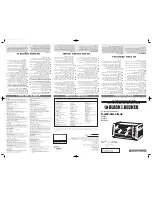
This section covers the servicing procedure for the oil boiler.
For servicing information on the heat pump, refer to the Installation
Instructions supplied.
To ensure efficient operation of the boiler it is recommended that
it is checked and serviced as necessary at regular intervals. The
frequency of servicing will depend upon the particular installation
conditions and usage, but in general once per year should be
adequate.
Servicing and replacement of parts must only be carried out by a
suitably qualified engineer.
Before starting any work on the boiler, or fuel supply please
read the health and safety information given in Section X.
External equipment operated at 230 volts should not be
serviced or repaired under adverse weather conditions.
!
WARNING
17.1 Checking Before Servicing
The following sequential checks should be made before any
servicing:
1. Check the flue terminal and ensure it is not blocked or
damaged.
2. Run the boiler and check the operation of its controls.
3. Ensure that all water/fuel system connections and fittings are
sound. Remake any joints and check the tightness of any
fittings that may be leaking.
4. If the boiler is used on a sealed central heating system, check
the system pressure, check the operation of the pressure relief
valve and check the expansion vessel air charge. See Section
7.2.
5. Refill, vent and re-pressurise the system as necessary. See
Section 7.3.
6. Check that the louvres in the front panel are clear.
7. Remove any sludge/water from the fuel tank by opening the
sludge valve at the lower end of the tank.
8. With the fuel supply valve closed, clean/replace the filter
element and clean the filter bowl.
9. Braided flexible fuel supply hoses (as supplied with the boiler)
should be replaced annually. If long-life hoses have been
installed, these should be inspected annually. If in doubt
replace the hoses. In any event, these hoses must be replaced
every five years.
Before servicing, set the boiler On/ Off switch to Off, isolate
the electricity supply and close the fuel supply valve.
!
WARNING
Allow the boiler to cool.
The data label on the inside of the case side panel will indicate the
fuel used and the nozzle fitted.
17 Servicing
17.2 Dismantling Prior to Servicing
The procedure for dismantling the boiler is as follows:
1. Remove the front panel by turning the handle and withdrawing
it forwards at the bottom.
2. Remove the four screws securing the top panel and carefully
lift it off, taking care not to damage the insulation.
3. Remove the burner fixing nut (top of mounting flange) and
withdraw the burner. If required, disconnect the flexible oil
hose(s), use a suitable container to prevent any oil spillage.
If two flexible hoses are connected to the burner, identify
(mark if necessary) which is the inlet and return if they are to
be disconnected.
NOTE
!
17.3 Cleaning the Boiler
The procedure for cleaning the boiler is as follows:
1. Remove the nuts and washers securing the front cleaning door
and withdraw the door. Take care - it is heavy.
2. Remove the baffles.
3. Remove all deposits from the baffle plates and all the boiler
internal surfaces using a stiff brush and scraper if necessary.
4. Check the condition of the flue, clean as necessary.
5. Check the condition of the front cleaning door seal, replace if
necessary.
6. Replace the baffles, ensuring they are correctly fitted.
7. Pull out the spiral turbulators from the heat exchanger tubes.
8. Clean the turbulators using a stiff brush
9. Test the heat exchanger condensate drain by pouring water
into one of the lower tubes and observe whether the water
discharges from the 22 mm condensate outlet. Replace the
turbulators.
10. Replace the front cleaning door, ensuring the seal is in good
condition and secure it in position with the nuts and washers
previously removed. Tighten to form a seal.
11. Remove the condensate trap and check that it is not blocked
and is operating correctly, i.e. the float is free to move. Clean
the trap and float as required. Refer to Section 6.8.
12. Check that the boiler condensate outlet is unobstructed. Clean
if necessary.
The condensate trap and condensate outlet must be checked
on every service and cleaned as necessary.
NOTE
!
Section 16: Servicing
Page 69
Содержание Aerona3 Series
Страница 57: ...Section 13 Flue System and Air Supply Page 57 Figure 13 8 Flue clearances...
Страница 77: ...Section 19 Spare Parts Page 77 Figure 19 4 15 21kW baffles Figure 19 5 21 26kW baffles...
Страница 84: ...Appendix A Page 84 Appendix A...
Страница 85: ...Appendix A Page 85...
Страница 86: ...Appendix A Page 86...
Страница 87: ...Appendix A Page 87...
















































